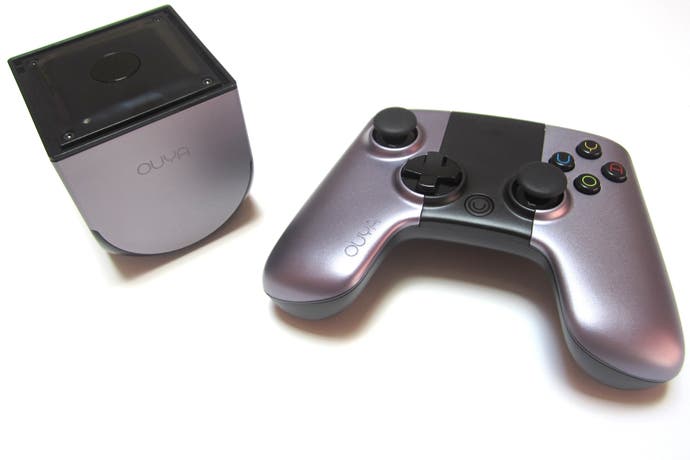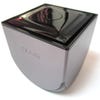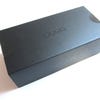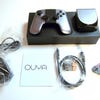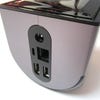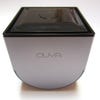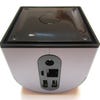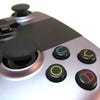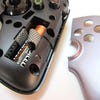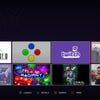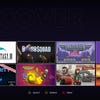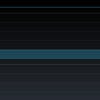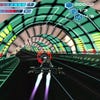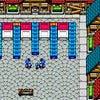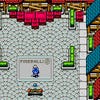Ouya review
Ouya devil.
Kickstarted to the tune of $8.5 million, the Ouya console is one of crowdfunding's high-profile success stories. Depending on who you listen to, it's also the system to pull the rug from beneath Sony, Microsoft and Nintendo and forever shake up the video game industry as we know it. It liberates players, empowers developers and creates a brave new world for interactive entertainment - or so we're told, at least. The hyperbole that has been written about Ouya would make the most seasoned spin doctor blush, but before you allow yourself to become too swept up in the hype, it's worth remembering that when all is said and done, Ouya is just Android in a set-top box - and we've already spoken about how potentially disappointing that particular reality could be.
Cutting through the rabid anticipation, Ouya does have a lot going for it. The console has been designed by Yves Béhar, it has a dedicated gaming-focused controller and is powered by Nvidia's Tegra 3 chipset - and to cap it all off, it will retail for a penny less than £100 when it launches in the UK later this month. In the US, it's a snip at $99. If Android is ever going to claim a place underneath your 50-inch LCD, this is surely its best chance - but does Ouya really pose a legitimate challenge to your PS3 and Xbox 360? Answering that question is predictably difficult at this early stage in the system's life, but we'll give it a go regardless.
In purely physical terms, Ouya is small. The first thing likely to strike you when you open the packaging and remove the touching "Thank You" note inserted by the team behind the console is just how diminutive the system is. Compared to traditional gaming hardware, it's absolutely tiny, although at 300 grams it has a heft which makes it feel solid and expensive. Béhar's design is destined to divide opinion: the minimalist appearance ensures it doesn't stick out like a sore thumb when placed next to your Blu-ray player and surround system, but a little more pizazz wouldn't have gone amiss. Still, there's a subtle, almost understated beauty to the machine, thanks to its glossy black top and sand-blasted aluminium casing. Around the back, you'll find an array of ports and outputs. HDMI, USB, Micro USB, Ethernet and power cables all dock here.
The controller is powered by two AA batteries, fitted behind metal panels which clip onto the main body of the pad via a set of magnets. The interface arrangement mimics that of the Xbox 360 controller, with the left-hand analogue stick raised slightly higher than the right-hand one in order to accommodate an eight-way digital pad. The face buttons adopt the now-standard diamond layout, and across the top there are four shoulder buttons - none of which offer analogue control, which could limit the machine's suitability for hardcore racing simulators and FPS titles. The middle of the controller has a small capacitive touchpad which acts as a mouse pointer and can be used to negotiate certain menus, but it's awkward to use and rarely provides the degree of accuracy you desire. Finally, there's the Ouya button, which can be held down to jump back to the main menu from any point. It's worth noting that by default, the Ouya is designed to run one application at a time - exiting back to the main menu will terminate the current game, so saving your progress is vital.
The Ouya pad's design certainly isn't unappealing, and it's comfortable to use. There are some minor niggles to contend with, however. The "O" button sticks slightly when pressed down hard, and while the analogue stick dead zone issues are mostly resolved, the sticks themselves are still rather heavy to use, making precise aiming rather a chore.
Because it's an Android device, adding peripherals to Ouya is blissfully easy. Bluetooth keyboards and mice can be paired with little fuss, making it much easier to input text and navigate menus. Additional Bluetooth gamepads can also be linked to the system, such as the official OnLive pad. OnLive is partnering with Ouya for the official launch, and while the unit we reviewed didn't have the app pre-installed (it's also absent from the Ouya store), we were able to sideload it onto the system and jump into a game of Batman: Arkham Asylum with the minimum of effort. By adding a USB hub, keyboard and mouse functionality is easily added and it's here that Ouya surprises as a pretty neat little browsing device - a world away from the world of hardship, endurance and woe encountered when using the Raspberry Pi.
"Ouya's OS is appealing and simple to use, but it is prone to some pretty awful lag when plenty of images are on-screen."
The Ouya is powered by Nvidia's Tegra 3 chipset, comprised of a 1.7GHz quad-core ARM Cortex-A9 CPU and a ULP Geforce GPU, all supported by just 1GB of RAM - around half the memory that most modern Android smartphones ship with. Tegra 3 was considered reasonably adept when Ouya was first announced, but with Tegra 4 already on the horizon, the console has effectively fallen foul of the smartphone world's breakneck pace of technological advancement. As a result, the performance of the system is acceptable rather than astonishing; the only benchmark we were able to successfully run was AnTuTu, which offered up a score of 13782 for the Ouya - well below the 23578 of the Samsung Galaxy S4, but better than the Galaxy S2, which achieved 10270 in the same test. Of course, it should always be remembered that Ouya costs around a fifth the price of your typical cutting-edge Android smartphone, so the comparison with the S4 isn't entirely fair, but the point is that in terms of overall 3D gaming power, the new console is already feeling dated and a year from now, it will be well behind the pace. It's not quite as power-efficient as we would have hoped for either - it consumes between 8-15W from the mains, depending on what it's doing.
Although Ouya is built around Google's Android OS, the UI is heavily skinned and it's only when you dig deep that the traditional "Halo" menu system appears. Upon firing up the console for the first time you are prompted to pair your controller, create an Ouya account and surrender your credit card details. The UI itself is divided into four key areas: Play (your library), Discover (the Ouya storefront), Make (accessing sideloaded apps and developer builds) and Manage (settings). The Discover section also contains a Sandbox area, where developers can upload pre-release editions of their games for other Ouya users to sample.
The console's online store offers a selection of games, all of which are free to download and play, thanks to the manufacturer's stipulation that all Ouya content offers gratis demos or free-to-play elements. For example, endless-runner Canabalt HD has a credit system which is renewed each day, with additional credits awarded for reaching 5000 metres in-game. Paying cash for the full version removes this limitation, as well as offering other bonuses, such as a different soundtrack and "classic" 2D visuals. It's a mechanic which means you can jump straight into the action and decide for yourself if a game is worthy of your cash, but there are issues here, too. There's no indication on the store listing page of how much each game costs - you only become notified at the point of purchase within the game itself. This is partly down to the fact that many of the games don't expect you to shell out for the full version once you've sampled the demo, because you're already playing the full version, and are expected to throw money at in-app purchases which grant more credit, items or time.
"With the UK launch just weeks away, Ouya really needs to step up its game - the lacklustre titles currently on offer simply aren't strong enough to carry a console launch."
At the time of writing, the Ouya storefront is rather lacking when compared to the likes of the iOS App Store and Google Play market - something which perhaps goes without saying, given the nascent nature of the hardware. Even so, it's disappointing that more titles aren't available, especially when you consider that during the system's Kickstarter campaign, the creators were mocking up store screens which showed everything from Shadowgun to Dead Trigger. The calibre of the current software line-up is patchy, to say the least; Final Fantasy III, Wizorb and The Bard's Tale rub shoulders with a range of throwaway mobile titles. While such games are acceptable smartphone time-wasters when you have a few minutes to kill, they feel hopelessly vacuous when experienced on a TV set.
In terms of raw graphical performance, it's impossible to shake the perception that Ouya is lagging behind the current crop of Android handsets. We tested a selection of games on the system, the most visually taxing being Real Racing 3, which we had to sideload (more on that later). The frame-rate was dire, and graphical glitches - such as missing textures and vanishing skies - further marred performance. Tegra-optimised titles should fare better, but none are available on the Ouya store at the time of writing - a bizarre omission when you consider how big a song and dance the Ouya team made about utilising Nvidia's tech. Other sideloaded efforts were more fruitful though - if this is something you're interested in pursuing, there are plenty of guides across the internet.
Much was made of the news that retro gaming emulators would be available on the Ouya store from day one, with critics pointing out that the system - which was supposed to be challenging companies like Nintendo - would allow users to illegally download and play classic SNES and N64 titles. At the time of writing, SNES9X, SuperGNES and Mupen64Plus are all available for download from the Ouya store, and more are likely to be released in the near future.
"Performance on 2D or 3D titles isn't exactly scintillating to say the least, even on some of the most simple games in the current line-up."
Performance is decent enough, with SNES9X running at full-speed with no frameskip. All of the controls map to the appropriate buttons on the Ouya's gamepad, too. News that you can play ROMs on the console should come as little surprise to seasoned Android supporters - after all, the Google Play market is bursting with emulators for a wide range of old systems - but it does make you wonder if Nintendo might possibly turn litigious when it realises that Ouya is potentially stealing market share by offering the means to play games which are currently available for premium download on the Wii U Virtual Console.
Given the Ouya's Android pedigree, you may harbour hopes that your collection of previously-purchased apps and games will function on this device. That's sadly not the case, as Ouya currently doesn't support the Google Play market. While it's possible to sideload Android applications by downloading and installing apk files in the storage section of the settings menu, Ouya refuses to play ball with the official Google Play app. Being able to install the Amazon App Store and SlideMe market mitigates this problem somewhat, but neither offers the breadth and depth of support that Google's digital storefront does. This presents a very real issue for long-time Android supporters - with no Play store access, there's no way to download all the games and apps that you've already purchased on your phone or tablet. Given that some of these very same games will be released on the Ouya store in the future with little more than slight optimisation to accommodate the controller, buyers may face the situation of having to re-purchase content they already own. It seems odd to build a system around Android and then refuse to give consumers the option of leveraging their existing library of purchases.
Still, from a purely business perspective, such a move is understandable. The team behind Ouya want to generate revenue from sales made on the console, and to curate and highlight games which make the most of the hardware's unique features - all of the games available have been especially configured to use the controller, something which obviously wouldn't be the case with standard Android titles - in fact, most of the non-Ouya optimised games we sideloaded were unplayable with the console's controller, which illustrates the need for a dedicated store. For the time being, the ability to sideload apps provides a short-term tonic, but developer support will be vital in the run-up to Christmas.
Another application for Ouya is a media player - although at this stage, you'll need to go to additional efforts to get things working, as the system has no playback software of any kind, nor is any available on the Ouya market. Sideloading a media player - such as XBMC or Plex - is possible, and Netflix also works when installed in this manner - although the lack of optimisation results in unstable performance. XBMC was unbearably slow, but Plex playback was excellent and the app worked beautifully with our in-house Plex server. The only official video-based Ouya offering right now appears to be a twitch.tv player, which - perhaps unsurprisingly - is very similar indeed to the stock Android app. It'll do the job but it's really short on options, like a search or chat.
"Ouya's controller issues appear to have been improved over the earlier models, but the pad itself still doesn't quite feel right and the touchpad is overly sensitive."
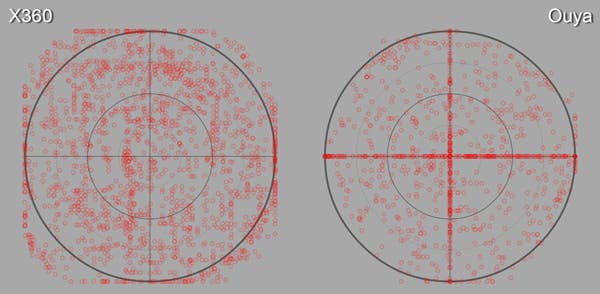
Ouya: the Digital Foundry verdict
Ouya's incredible journey to market may make it appear like an overnight success, but in reality the console has a long and hard road ahead of it before it can truly be considered a viable alternative to traditional consoles. The Ouya store is embarrassingly short on must-have titles, and with exclusives such as the Human Element prequels not ready for launch, the system may struggle to prove itself before the next generation of home gaming begins in earnest. Even without the PS4 and Xbox One looming on the horizon, Ouya is hard to recommend when you can pick up a brand new Xbox 360 for just £30 more - and it's not as if there's a shortage of games available there for dirt-cheap prices.
What Ouya stands for is more definitely worth supporting; it's a low-cost and highly customisable console which offers small-scale developers a decent platform, but it is by no means unique in this field - both iOS and Android offer a significantly larger install base, and in the case of Android, can do pretty much everything Ouya can. Many of the latest Android phones boast HDMI capability, and all devices running a recent version of Google's OS can link up to Bluetooth pads for a true gaming experience. This begs the question: why bother spending £99 on another piece of tech when you can achieve largely the same result with your mobile phone, which is bought and paid for as part of your monthly contract?
If Ouya is successful enough to secure big exclusives, things could be different. Should the system find its Mario, Halo or Uncharted, it could well break free of its smartphone roots and establish itself as a platform worthy of mainstream acceptance. However, when "exclusive support" from the likes of Square Enix equates to little more than offering a port of Final Fantasy III which is already available on several other formats, it's clear that Ouya's future is a long way from being assured - the news that Sega is set to release three Sonic games which have been on the Google Play and iOS App Store for months is another worrying example. When developers know that making a game for Ouya also means having the opportunity to port it to Android and hit a potentially much larger audience, truly exclusive releases might end up being rather thin on the ground.
While Ouya offers a lukewarm experience at present, it's still very early days yet. With the promise of yearly hardware updates already coming from the team behind the system, Ouya is certainly going to evolve, just as smartphones and tablets continually advance in terms of internal tech. Of course, such evolution can only occur when there's enough interest and cash involved, and time will tell if Ouya can overcome its ageing internal tech and lack of exclusive software to carve out a niche in the marketplace. Despite some irksome teething troubles, the console at least has the basic building blocks in place, and comes with a decent price point - now it just needs the robust developer support that was promised during that famous Kickstarter campaign last year.
